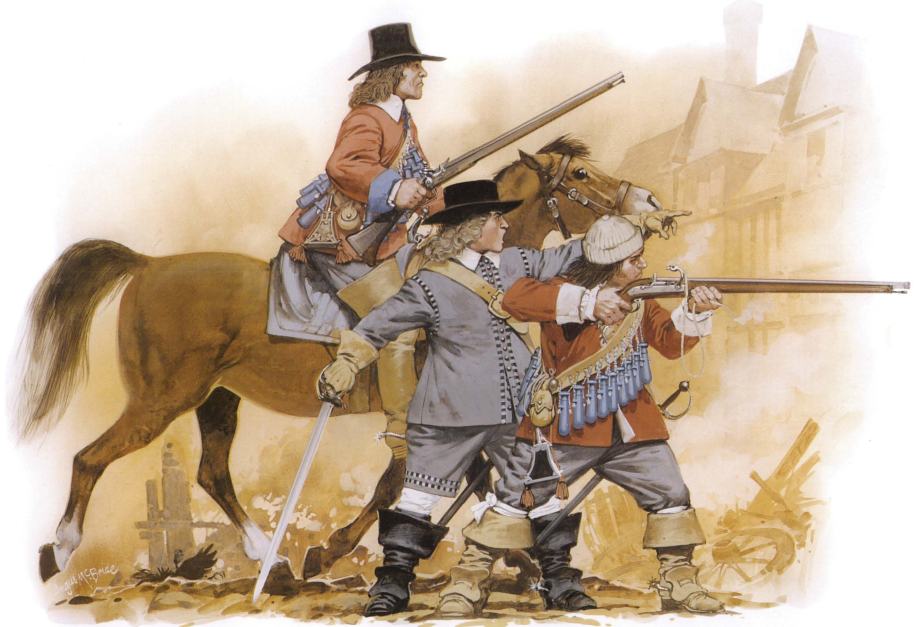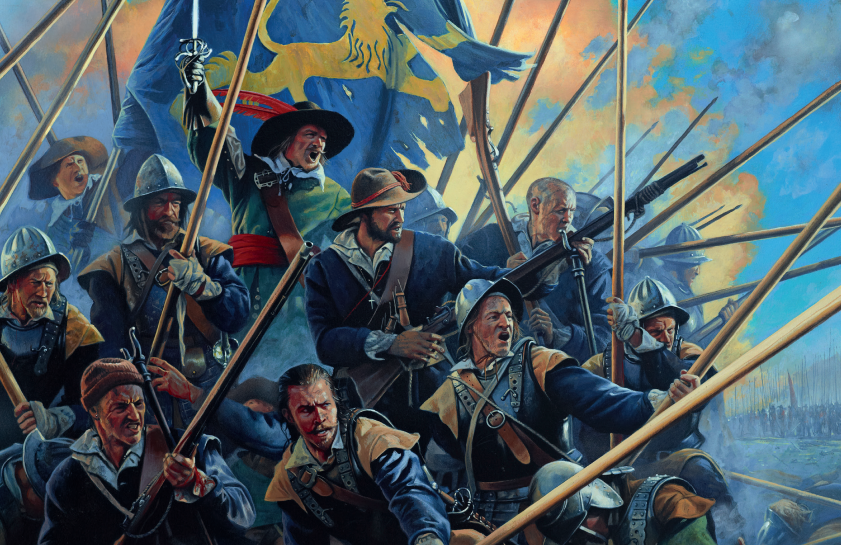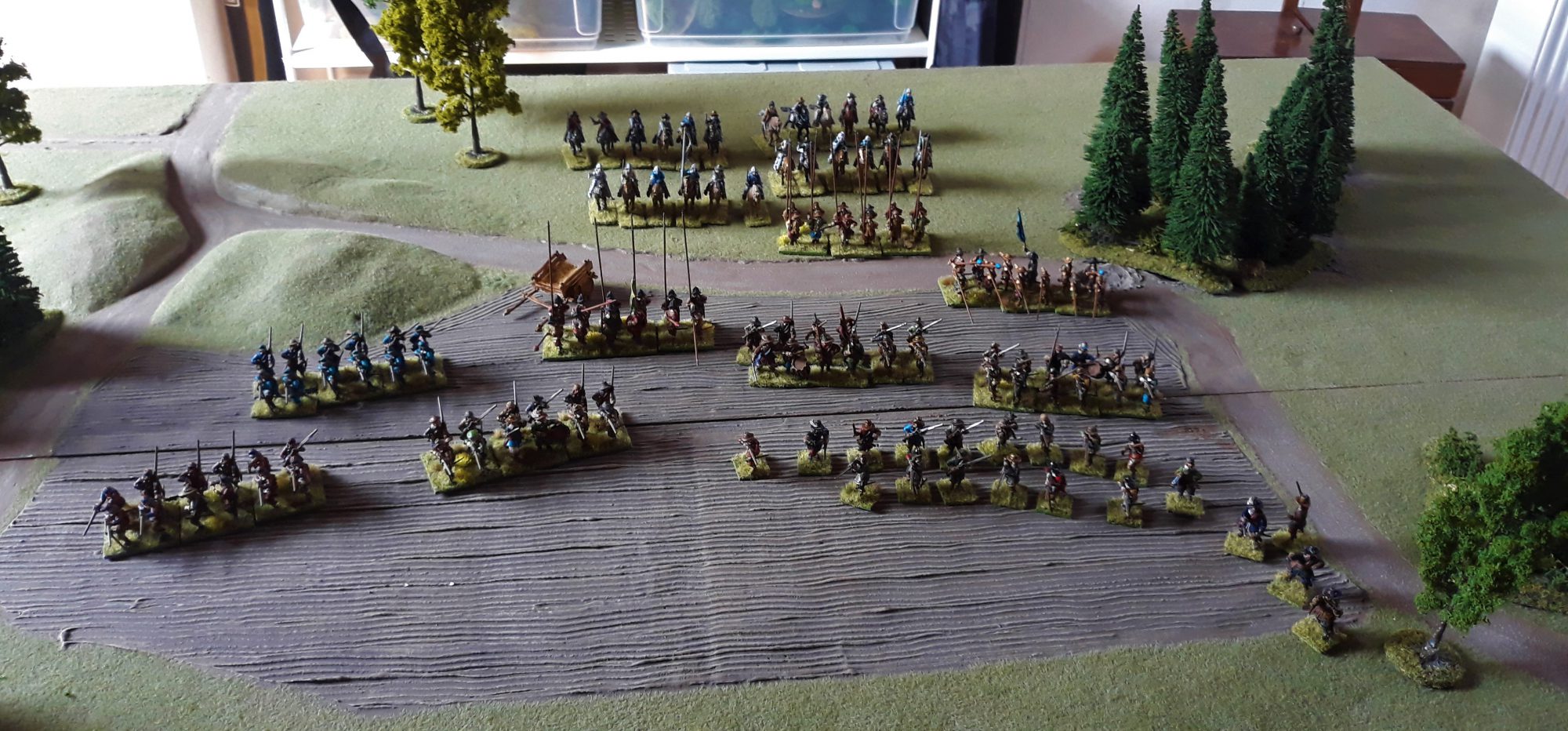Ah yes, the thirty years’ war, most popular of historical periods! Despite this being a relatively niche period to explore, it ticks a lot of boxes: defenestrations! Pike blocks! Flouncy shirts! 30 years of misery that can still be noticed in the demographics of certain German regions today!
The context in which this conflict played out was a very different Europe indeed. The great nation states are still a faraway dream, and vying royal houses actively pursued their interests. To say the conflict was solely a war based on religion would underestimate the political machinations of monarchs who were less the limp handwaving kind, and more of the strap on armour and get stuff sorted type (If they’d have a jolly tins of biscuits they would probably be portrayed as beheading someone). But times were changing. The battlefield demanded new tactics to counter the changing ways of war, with older methods going slowly obsolete. This was the beginning of the end of the great pike blocks, which until this time were dominating the battlefields from Italy to Flanders. Gunpowder would soon become the deciding factor, with more reliable and accurate weapons being developed, and the role of cavalry was heavily influenced by this.
The war roughly played out in two phases: starting in 1618 with a revolt in Bohemia against Habsburg favored successor Ferdinand II, after some Protestant leaders feared that they might lose their religious rights given to them in a previous treaty. The Catholic representatives were promptly thrown out of the window (that’s actually the third Prague defenestration, so almost a tradition at that point), and kicked off the revolt. Unfortunately it didn’t end in a revolt in one state. After the death of Emperor Matthias and succession of Ferdinand II, the war spread out over the rest of Roman Holy Empire, and the other monarchies took a keen interest and gave support to either the Protestant or Catholic side. This was an exciting time to say the least. The Bohemians (but not all of them) backed Frederick V as successor, but also made the position open for other interested parties, widely considered as the worst HR move in Bohemia ever. The Catholics involved Spain, while Denmark, Sweden and the Dutch Republic backed the protestants.
The second phase started roughly around 1635, when France and its allies joined in and so almost all of Europe was at war, with the 80 year’s war still raging on in Flanders and the Netherlands (also an apparent religious conflict).
The Peace of Westphalia (actually an amalgation of different treaties), was signed in 1648, ending the conflict, and leaving a country in ruin. The bill was high: between 4- 8 million people died, most of these deaths from illness and famine. Although there are a few standout battles, this war was waged with sieges, smaller skirmishes, and on an empty stomach. Quarter was not given as enemy troops looted and burned to supply themselves, ragged men scraping the land for sustenance.
To situate the period you need more than a couple of paragraphs and omitted papal influence, but a good starting point that’s accessible (if a bit dry here and there) is Osprey’s aptly named Guide. They also have excellent volumes on the uniforms and tactics of the different forces.
Most of the blue book series are rather smaller in scope than the typical mega-battles you’ll probably find at a wargaming convention. This ruleset, written by Daniel Mersey, is actually a good jump-off point if you’re interested in gaming the period, as most battles have 60-odd miniatures per side, which should roughly add up to one army if you consider branching out to other rulesets.
One of the unwritten rules of gaming this sort of thing is that you’ll probably be providing both sides of the conflict. Like my Italian wars stuff, it’s difficult to convince people to buy and assemble, let alone paint a couple of pike blocks. There’s a reason it’s called a lament you see.
What you’ll need
- Depending on game size, really. You can compose a force entirely of cavalry, or go for a mass of rabble if you like. A rather standard army has 2 units of horse (6 models each) a couple units of pike and shotte (12 models each) and maybe some forlorn hope units, or a regimental gun. A pike and shotte starter from Warlord Games has basically all the stuff you need to get a 2-player game going.
- 12 D6’s
- A tape measure and maybe some measuring widgets
- A 4×4 playing surface, at minimum (4×6 is better in my opinion)
- Some terrain, there are some scenarios that have specific terrain you’ll need to assemble. Some assorted trees and bushes and maybe a house to spruce up your table are usually more than sufficient. Some scenarios do call for specific stuff, but that’s not needed for your first games.
When diving into the rulebook for the first time, you’ll notice three things; 1) Osprey blue books are not ideally laid out 2) If you’ve played Lion Rampant, Rebels and patriots, The Men Who Would be Kings or Dragon Rampant, the basic mechanics will look very familiar, as they’ve pretty much got the same engine under the bonnet 3) a sudden urge to do research on the period.
That engine will immediately be a hit or a miss for most people. Pikeman’s Lament is first and foremost a push your luck game, where you have to roll prior to taking an activation with a unit. Different actions have a higher or lower chance of success, and failing a roll will end your turn. This isn’t a system for everybody. Personally I love this simplified fog of war, where you’re not certain everything can or will activate. It is an effective way to simulate the chaos of battle and small skirmish actions. Certainly in later turns it becomes very important which units you want to activate, and the tension rises as casualties start to mount.
As I’ve mentioned the book is laid out in the typical Osprey fashion, starting with the units you’ll use before moving on to the bulk of the rules. It’s important to note that this causes a fair amount of flipping back and forth in the book, and there’s no gentle way to ease you into the game. Fortunately the rules aren’t that hard to grasp, and you’ll rarely need to refer back to the book once you’ve played a couple of games. There are plenty of resources available like unit cards and quick reference sheets that list the most important rules and play sequence.
Speaking of which, turnover happens quickly, so there is a fluidity and swiftness to gameplay which makes it feel different from the usual IGO-UGO games. No rolling for initiative, the attacker tries to activate his units first and goes on activating units until they’re done or there’s a failed roll. Play proceeds until scenario objectives (or honour, in this case) are met or one of the forces is routed. After a couple of games you won’t be thinking in turns as much as activations.

The second mechanic that stands out is the casualty removal. Every unit has a stamina stat, which equals the number of hits needed to remove models. If you have a unit with 2 stamina, you’d need at least 2 hits to remove a model. So if your roll 12 dice with a full unit of musket, and score 8 hits, 4 models are removed. Line of sight is a simple: 360° vision with some simple cover rules. As a result, games move at a swift pace and you’ll barely break the 90 minute mark.
Although there isn’t a fully fledged campaign system, there is a bit of variety when picking your force as you roll for leader traits. Tactical genius or sniveling coward? This gives some nice flavor to games and playing games in succession and adding a trait seems like an easy way to have some linked games without too much bookkeeping. Also you leaders can call each other out and duel, which happens fairly often, often with hilarious (depends) results.
How to paint pikes
Luckily, fellow author Lenoon has done an excellent overview of the miniatures available in his article about getting started in the (slighty more popular) English Civil War, so I won’t reproduce that here. If you’re looking at painting your models in appropriate colors, the aforementioned Osprey guides are excellent starting points. The upside is that the period is very much the start of actual matching uniforms or at least garments, so you can create a ragtag band of misfits or a more consistent force led by a wealthy noble who could afford enough colored cloth. I’ve had a couple of discussions about this subject, but as with other periods that have little information about this subject it’s a better idea to just pick something that will look good on the tabletop.
So let’s just recap who this game is for and what it means to achieve. You won’t find a faithful recreation of large battles, but that is explicitly not the point. As mentioned by the author in the preface, this is very much a skirmish ruleset for a period that was known for raids, looting and small scale actions. Games are enjoyable and fast, and some finesse is required to get a win.
So it’s ideally suited to get some models on the table and give your freshly painted (we are playing historicals here) an airing. When working on a larger project, you won’t have to postpone games until it’s finished. Iif you want to dip your toe in the period, it’s a nice starting point that lets you get a feel for it without having to invest heavily into models, which will inevitably accumulate in your backlog.
You can find the rules on the Osprey site, or order it through most book stores.
Have any questions or feedback? Drop us a note in the comments below or email us at contact@goonhammer.com.





